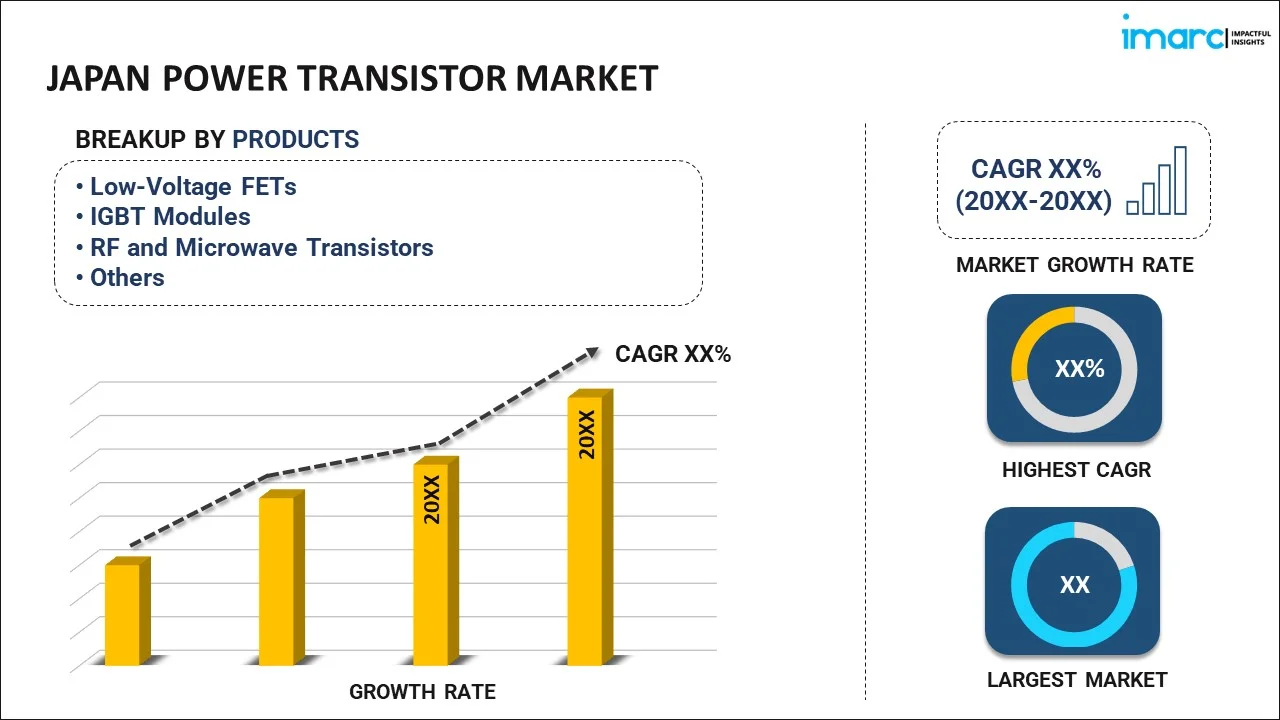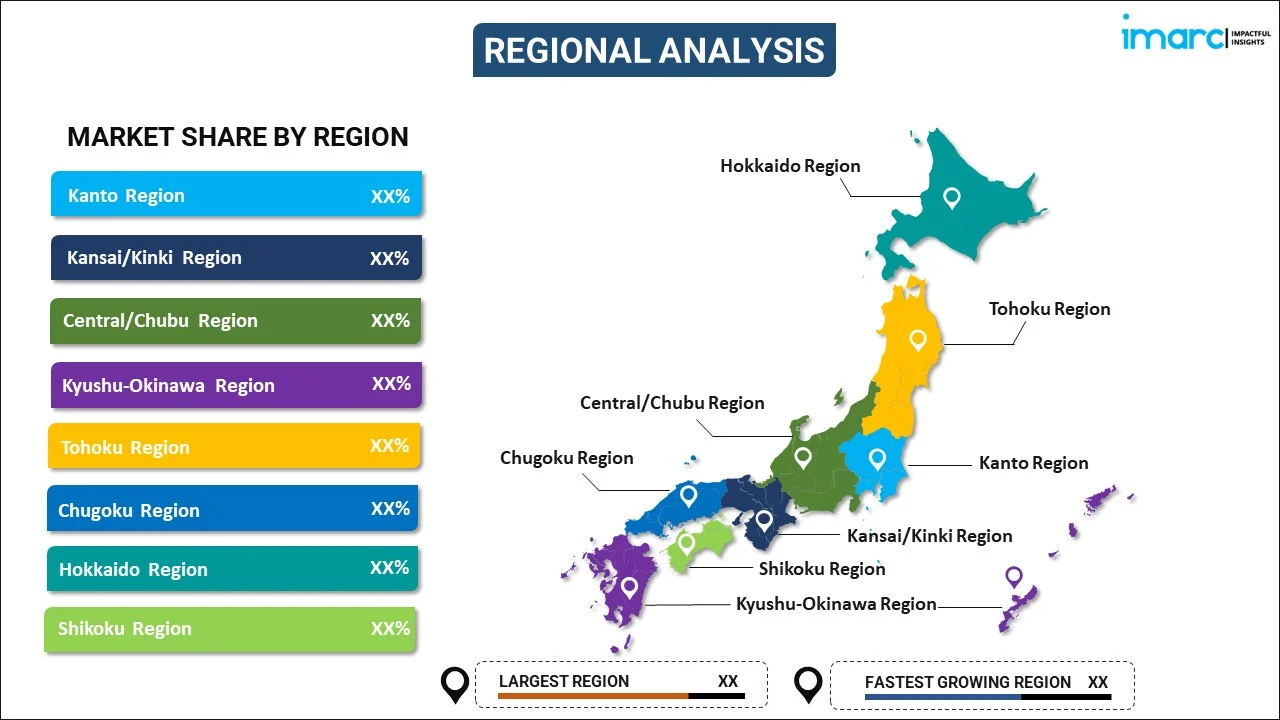
Japan Power Transistor Market Report by Product (Low-Voltage FETs, IGBT Modules, RF and Microwave Transistors, High Voltage FETs, IGBT Transistors), Type (Bipolar Junction Transistor, Field Effect Transistor, Heterojunction Bipolar Transistor, and Others), End Use Industry (Consumer Electronics, Communication and Technology, Automotive, Manufacturing, Energy and Power, and Others), and Region 2025-2033
Market Overview:
Japan power transistor market size reached USD 761.1 Million in 2024. Looking forward, IMARC Group expects the market to reach USD 1,036.6 Million by 2033, exhibiting a growth rate (CAGR) of 3.23% during 2025-2033. The rising popularity of power-efficient electronic devices, on account of the increasing usage of fossil fuels, is primarily driving the market growth.
|
Report Attribute
|
Key Statistics
|
|---|---|
|
Base Year
|
2024 |
|
Forecast Years
|
2025-2033
|
|
Historical Years
|
2019-2024
|
| Market Size in 2024 | USD 761.1 Million |
| Market Forecast in 2033 | USD 1,036.6 Million |
| Market Growth Rate (2025-2033) | 3.23% |
Power transistors are pivotal elements designed for high-voltage operations, serving both as amplifiers and switches. They consist of three semiconductor junctions termed as base, collector, and emitter, enabling the transistor to alternate between conductive and non-conductive states. These junctions can adopt either the PNP or NPN configuration and come with varied power and transition speed specifications. In the contemporary electronic landscape, power transistors are gaining immense popularity due to their role in enhancing the switching precision and bolstering the energy efficiency of electronic devices. Their ability to dissipate heat promptly ensures prevention of overheating, which, in turn, reduces electricity consumption and CO2 emissions. Given these advantages, they have become indispensable in numerous electronic applications.
Japan Power Transistor Market Trends:
The Japan power transistor market is an emblem of the country's technological prowess and its commitment to advancing electronics. As one of the global hubs for electronics and semiconductor manufacturing, Japan has consistently driven innovations in the power transistor segment. A prevailing trend is the miniaturization of electronic components. As devices become more compact and efficient, there's a surge in demand for smaller, more powerful transistors that can manage heat effectively and operate at optimal efficiency. This has spurred research and development in advanced materials and design methodologies, ensuring that power transistors meet these evolving requirements. Another driver is the rise of green and energy-efficient technologies. As Japan grapples with its energy needs and environmental commitments, the emphasis on creating energy-efficient electronics is paramount. The expanding landscape of the Internet of Things (IoT) in Japan also plays a pivotal role. With a multitude of devices getting interconnected, the need for efficient, reliable, and durable power transistors is more pronounced than ever. Furthermore, governmental policies promoting technological innovation, coupled with substantial investments in research and development by private sector giants, are shaping the trajectory of the market. In summary, driven by technological advancements, evolving consumer demands, and a holistic push towards sustainability and efficiency, the Japan power transistor market is poised for significant growth and transformation in the coming years.
Japan Power Transistor Market Segmentation:
IMARC Group provides an analysis of the key trends in each segment of the market, along with forecasts at the country level for 2025-2033. Our report has categorized the market based on product, type, and end use industry.
Product Insights:

- Low-Voltage FETs
- IGBT Modules
- RF and Microwave Transistors
- High Voltage FETs
- IGBT Transistors
The report has provided a detailed breakup and analysis of the market based on the product. This includes low-voltage FETs, IGBT modules, RF and microwave transistors, high voltage FETs, and IGBT transistors.
Type Insights:
- Bipolar Junction Transistor
- Field Effect Transistor
- Heterojunction Bipolar Transistor
- Others
A detailed breakup and analysis of the market based on the type have also been provided in the report. This includes bipolar junction transistor, field effect transistor, heterojunction bipolar transistor, and others.
End Use Industry Insights:
- Consumer Electronics
- Communication and Technology
- Automotive
- Manufacturing
- Energy and Power
- Others
The report has provided a detailed breakup and analysis of the market based on the end use industry. This includes consumer electronics, communication and technology, automotive, manufacturing, energy and power, and others.
Regional Insights:

- Kanto Region
- Kansai/Kinki Region
- Central/ Chubu Region
- Kyushu-Okinawa Region
- Tohoku Region
- Chugoku Region
- Hokkaido Region
- Shikoku Region
The report has also provided a comprehensive analysis of all the major regional markets, which include Kanto Region, Kansai/Kinki Region, Central/ Chubu Region, Kyushu-Okinawa Region, Tohoku Region, Chugoku Region, Hokkaido Region, and Shikoku Region.
Competitive Landscape:
The market research report has also provided a comprehensive analysis of the competitive landscape in the market. Competitive analysis such as market structure, key player positioning, top winning strategies, competitive dashboard, and company evaluation quadrant has been covered in the report. Also, detailed profiles of all major companies have been provided.
Japan Power Transistor Market Report Coverage:
| Report Features | Details |
|---|---|
| Base Year of the Analysis | 2024 |
| Historical Period | 2019-2024 |
| Forecast Period | 2025-2033 |
| Units | Million USD |
| Scope of the Report | Exploration of Historical and Forecast Trends, Industry Catalysts and Challenges, Segment-Wise Historical and Predictive Market Assessment:
|
| Products Covered | Low-Voltage FETs, IGBT Modules, RF and Microwave Transistors, High Voltage FETs, IGBT Transistors |
| Types Covered | Bipolar Junction Transistor, Field Effect Transistor, Heterojunction Bipolar Transistor, Others |
| End Use Industries Covered | Consumer Electronics, Communication and Technology, Automotive, Manufacturing, Energy and Power, Others |
| Regions Covered | Kanto Region, Kansai/Kinki Region, Central/ Chubu Region, Kyushu-Okinawa Region, Tohoku Region, Chugoku Region, Hokkaido Region, Shikoku Region |
| Customization Scope | 10% Free Customization |
| Post-Sale Analyst Support | 10-12 Weeks |
| Delivery Format | PDF and Excel through Email (We can also provide the editable version of the report in PPT/Word format on special request) |
Key Questions Answered in This Report:
- How has the Japan power transistor market performed so far and how will it perform in the coming years?
- What has been the impact of COVID-19 on the Japan power transistor market?
- What is the breakup of the Japan power transistor market on the basis of product?
- What is the breakup of the Japan power transistor market on the basis of type?
- What is the breakup of the Japan power transistor market on the basis of end use industry?
- What are the various stages in the value chain of the Japan power transistor market?
- What are the key driving factors and challenges in the Japan power transistor?
- What is the structure of the Japan power transistor market and who are the key players?
- What is the degree of competition in the Japan power transistor market?
Key Benefits for Stakeholders:
- IMARC’s industry report offers a comprehensive quantitative analysis of various market segments, historical and current market trends, market forecasts, and dynamics of the Japan power transistor market from 2019-2033.
- The research report provides the latest information on the market drivers, challenges, and opportunities in the Japan power transistor market.
- Porter's five forces analysis assist stakeholders in assessing the impact of new entrants, competitive rivalry, supplier power, buyer power, and the threat of substitution. It helps stakeholders to analyze the level of competition within the Japan power transistor industry and its attractiveness.
- Competitive landscape allows stakeholders to understand their competitive environment and provides an insight into the current positions of key players in the market.
Need more help?
- Speak to our experienced analysts for insights on the current market scenarios.
- Include additional segments and countries to customize the report as per your requirement.
- Gain an unparalleled competitive advantage in your domain by understanding how to utilize the report and positively impacting your operations and revenue.
- For further assistance, please connect with our analysts.
 Inquire Before Buying
Inquire Before Buying
 Speak to an Analyst
Speak to an Analyst
 Request Brochure
Request Brochure
 Request Customization
Request Customization




.webp)




.webp)












